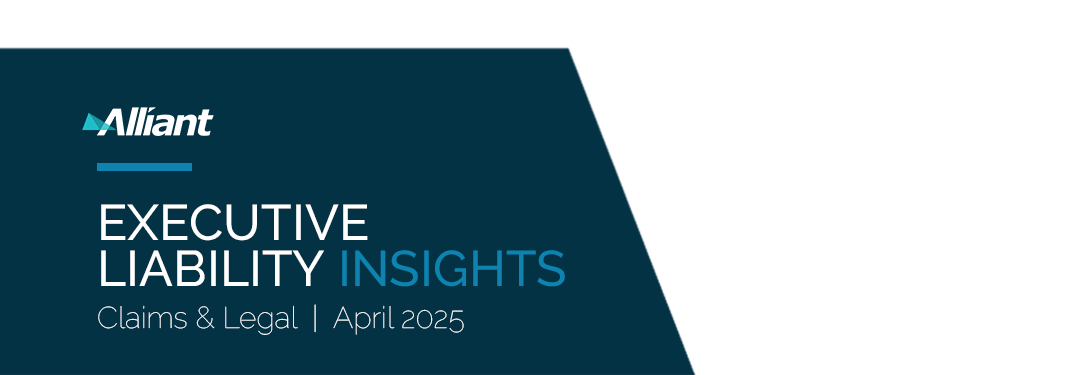
Navigating today’s complex risk environment can be a monumental task. Steve Shappell, Alliant Claims & Legal, spearheads Executive Liability Insights, a monthly review of news, legal developments and information on executive liability, cyber risk, employment practices liability, class action trends and more.


FEATURED ARTICLE
INSURERS AVOID COVERAGE BASED ON CHANGES IN EXPOSURE PROVISION
Previously, we reported on the lower court’s decision that a policy’s “Changes in Exposure” provision precluded coverage for an acquired bank under the acquirer bank’s insurance policies despite the policies defining “predecessors in business” as insureds. The decision was appealed and affirmed by the Third Circuit.
In This Issue:
INSURERS NOT OBLIGATED TO COVER BIPA CLAIMS UNDER BROAD RECORDING-AND-DISTRIBUTION EXCLUSION
Ohio Security Insurance Co. et al. v. Wexford Home Corp., 2025 Ill. LEXIS 318 (Ill. Sup denied Mar. 26, 2025).
The Illinois Supreme Court declined to review an appellate decision without further explanation despite conflicting case law on the issue. The appeal rested on whether insurers were obligated to defend an insured against claims that it collected employees’ fingerprints for timekeeping during work hours without consent.
Read More >>
AUTOMAKER SETTLES FOR ALLEGED VIOLATIONS OF CALIFORNIA CONSUMER PRIVACY ACT
The state agency dedicated to enforcing the California Consumer Privacy Act (“CCPA”) revealed its settlement with an automaking company (the “Automaker”). This settlement is of note because it marks the agency’s first enforcement action since its creation.
Read More >>
TWO CASES FILED 18 YEARS APART ARE DEEMED UNRELATED IN A FACT INTENSIVE ANALYSIS
NFL v. United States Specialty Ins. Co., 654411/2022 (N.Y. April 3, 2025).
A New York court, through a side-by-side comparison of two complaints filed eighteen years apart found the allegations were insufficient to enmesh otherwise distinct claims. In 1997, several individuals filed a class action lawsuit against a professional sports league (the “League”) and its teams.
Read More >>
COURT RULES THAT UNREAD E-MAILS TRIGGER CLAIMS-MADE POLICY UPON RECEIPT
Landmark American Insurance Co. v. NurSelect LLC, No. 5:24-cv-01412-GAW (E.D. Pa. March 3, 2025).
A federal court held that an e-mail notification constituted a “claim” under a liability insurance policy at the time when the e-mail was first “received,” and not when the Insured first became aware of its receipt.
Read More >>
CYBER CORNER
Click to read the following cases:
- DON’T “TEST” THE COURT’S PATIENCE: ENTERPRISING PLAINTIFF GETS DRESSED DOWN IN DATA PRIVACY SUIT
- INSURERS SUFFER A LOSS IN DATA BREACH SUBROGATION SUIT
- DISTINCT POLICY LANGUAGE DETERMINED OUTCOME IN A COVERAGE DISPUTE ARISING FROM SOCIAL ENGINEERING SCHEME
- FEDERAL COURT DISMISSES DATA BREACH CLASS ACTION FOR FAILURE TO TRACE INJURY TO COMPROMISED PERSONAL INFORMATION
Read More >>
EMPLOYEMENT CORNER
Click to read the following cases:
- BREACH OF CONTRACT EXCLUSION BARS COVERAGE UNDER BOTH D&O AND EPL COVERAGE SECTIONS
- A POSITIVE TEXAS COURT RULING FOR PROPONENTS OF ESG
Read More >>
SECURITIES CORNER
Click to read the following cases:
- SEC WITHDREW ITS DEFENSE RELATED TO THE CLIMATE DISCLOSURE RULES
- MARCH 2025 NOTEWORTHY ENFORCEMENT ACTIONS FILED
- MARCH 2025 NOTEWORTHY SETTLEMENTS AND JUDGEMENTS
Read More >>
SHAREHOLDER CORNER
Click to read the following cases:
- MARCH 2025 SECURITIES CLASS ACTION FILINGS
Read More >>
INSURERS AVOID COVERAGE BASED ON CHANGES IN EXPOSURE PROVISION
PNC Bank NA v. Axis Ins. Co. et al., 2025 U.S. App. LEXIS 6651 (3d Cir. Mar. 21, 2025).


Previously, we reported on the lower court’s decision that a policy’s “Changes in Exposure” provision precluded coverage for an acquired bank under the acquirer bank’s insurance policies despite the policies defining “predecessors in business” as insureds. The decision was appealed and affirmed by the Third Circuit.
Following the acquisition of another bank, the acquirer bank was sued for the acquired bank’s mismanagement of trust accounts which occurred years before the purchase transaction. The insured bank sought coverage, arguing that its financial institution professional liability coverage included "predecessors in business" in the definition of Insured. However, the insurers argued that the “Changes in Exposure” provision excluded coverage for wrongful acts committed by the acquired bank prior to the transaction.
The policy’s Changes in Exposure Provision stated:
If, during the Policy Period: (i) an organization or entity becomes a Subsidiary, or (ii) the Company acquires any organization or entity by merger into or consolidation with the Company, then coverage shall apply to such organization or entity and the Insureds of such organization or entity, but only with respect to Wrongful Act(s) committed, attempted, or allegedly committed or attempted, at the time of or after such event, unless the Underwriter agrees, after presentation of all appropriate information, to provide coverage by endorsement for Wrongful Act(s) by such Insureds prior to such event.
The insured argued that the provision did not apply because the bank was a subsidiary of the Parent Company when it made the acquisition, incurred the judgment and defended the lawsuit, and is seeking coverage for itself, not on behalf of the acquired bank. The third circuit dismissed this argument and found that “under the provision, if [the bank] or the Parent Company acquires another company, the insurers will not cover claims for wrongful acts committed by the acquired company before the acquisition occurred.” Because the underlying lawsuit focused on the acquired bank’s wrongful acts taken before the acquisition, the Changes in Exposure Provision applied. “That [the bank] became the successor in interest to [the acquired bank], defended the lawsuit, and paid the judgment does not negate the provision's application; indeed, it contemplated that sequence of events.”
INSURERS NOT OBLIGATED TO COVER BIPA CLAIMS UNDER BROAD RECORDING-AND-DISTRIBUTION EXCLUSION
Ohio Security Insurance Co. et al. v. Wexford Home Corp., 2025 Ill. LEXIS 318 (Ill. Sup denied Mar. 26, 2025).


The Illinois Supreme Court declined to review an appellate decision without further explanation despite conflicting case law on the issue. The appeal rested on whether insurers were obligated to defend an insured against claims that it collected employees’ fingerprints for timekeeping during work hours without consent.
In the underlying matter, current and former employees filed a class action lawsuit against the insured, a wall décor company (the “Company”). The lawsuit alleged that the Company violated the Biometric Information Privacy Act (“BIPA”) by requiring fingerprint scans without providing written notice, obtaining consent, or disclosing it was storing data.
The Company sought coverage under its primary and umbrella liability policies. However, the Insurers denied coverage, citing various exclusions. The Insurers argued the recording-and-distribution exclusion was triggered as it barred coverage for any “personal and advertising injury” arising out of the unlawful recording or distribution of information.
The Insurers cited controlling authority, which broadly interpreted identical policy language to exclude coverage for unlawful data collection and recording. Conversely, the Company argued that the exclusion was ambiguous based on conflicting case law which rejected the application of a similar exclusion to BIPA claims.
The appellate court, relying on precedent the Insurer cited, held that the exclusion unambiguously barred coverage for the BIPA claims due to its catch-all language. The court distinguished this decision from the Company’s cited case law where the exclusion’s title was deemed ambiguous and did not sufficiently encompass the coverage sought.
AUTOMAKER SETTLES FOR ALLEGED VIOLATIONS OF CALIFORNIA CONSUMER PRIVACY ACT


The state agency dedicated to enforcing the California Consumer Privacy Act (“CCPA”) revealed its settlement with an automaking company (the “Automaker”). This settlement is of note because it marks the agency’s first enforcement action since its creation.
In 2023, the agency announced that it will investigate practices of car manufacturers; however, to everyone’s surprise, the investigation was not auto-specific. Instead, the agency’s focus on web-based privacy practices apply to virtually any company that operates an online consumer interaction platform.
The settlement highlights that CCPA will look at virtually everything: from how quickly a given company would be able to produce its contracts with third party vendors, to how many steps it would take to opt-out of sharing their personal information. The agency focused on the Automaker requiring slightly more data points for opt-outs, than opt-ins, and, according to the agency, this “choice [was] not a symmetrical” one.
The agency, which was previously committed to drafting its rules, is now demonstrating how even gaps in documentation or technicalities could result in material consequences. Therefore, companies should be incentivized to take remedial steps to comply with the CCPA and ensure that consumers have an easy and user-friendly pathway to exercise their privacy rights under the law.
TWO CASES FILED 18 YEARS APART ARE DEEMED UNRELATED IN A FACT INTENSIVE ANALYSIS
NFL v. United States Specialty Ins. Co., 654411/2022 (N.Y. April 3, 2025).


A New York court, through a side-by-side comparison of two complaints filed eighteen years apart found the allegations were insufficient to enmesh otherwise distinct claims.
In 1997, several individuals filed a class action lawsuit against a professional sports league (the “League”) and its teams. The lawsuit argued that the League “contracted and agreed to restrict the output of the broadcast of their games on non-exempt channels of distribution,” and “agreed to jointly sell their broadcast rights to purchasers of satellite television programming at supra-competitive pricing.” The individuals further argued that the League and the non-party television provider (the “Provider”) entered into an agency agreement, whereby the Provider was authorized to act as an agent of the League to sell and distribute the at issue viewing package. This action settled several years later.
Now, eighteen years later, the League sought coverage from its D&O program following an antitrust lawsuit against them and now-a-co-defendant, the Provider, which alleged the agreements between the League and the Provider eliminated competition, allowed “supra-competitive monopoly prices,” and required individuals to pay for a package that covered all teams. The primary issue was whether coverage was precluded by a Pending and Prior Litigation clause given the 1997 lawsuit.
The League argued that the Pending and Prior Litigation clause was not applicable because the prior litigation and the current litigation are not a single “Claim” under the policies at issue. However, the carriers argued that this matter was excluded due to the Pending and Prior Litigation clause because:
the Insurer shall not be liable to make any payment for Loss in connection with any Claim made against any Insured: (C) alleging, arising out of, based upon, or attributable to, as of the Continuity Date, any pending or prior (i) litigation; or (ii) administrative or regulatory proceeding or investigation of which an Insured had notice, or alleging any Wrongful Act which is the same or Related Wrongful Act to that alleged in such pending or prior litigation or administrative or regulatory proceeding or investigation.
The court, siding with the League, reasoned that resolution of whether the prior litigation and the current litigation constituted a single “Claim,” required the plain language of the policy and a side-by-side comparison of the complaints. The primary policy defined a “Related Wrongful Act” as “all Wrongful Acts that are logically or causally connected by any fact, circumstance, situation, event, transaction…” While related wrongful acts are defined broadly as all that are logically and casually connected, there must be a relatedness, i.e. sufficient factual nexus. When claims are “temporally separate” there is not a sufficient factual nexus. Additionally, the court highlighted that the two complaints do not involve the same transaction. The prior litigation focused on the alleged conspiracy of the League to sell their broadcast rights thereby limiting individuals ability to view games outside of their area. Whereas the current litigation challenged the agreements between the League and the Provider which granted the Provider exclusive license to sell and set prices of the package. Thus, the Pending and Prior Litigation clause did not preclude coverage.
COURT RULES THAT UNREAD E-MAILS TRIGGER CLAIMS-MADE POLICY UPON RECEIPT
Landmark American Insurance Co. v. NurSelect LLC, No. 5:24-cv-01412-GAW (E.D. Pa. March 3, 2025).


A federal court held that an e-mail notification constituted a “claim” under a liability insurance policy at the time when the e-mail was first “received,” and not when the Insured first became aware of its receipt.
The underlying matter arose out of a negligence claim involving a worker who the insured, a healthcare staffing agency (the “Agency”), staffed for a nursing home. The nursing home sought indemnification and notified the Agency’s president in an e-mail about an impending joinder complaint. The president failed to acknowledge the e-mail for several months until after the policy period renewed. The Insured sought coverage under the new policy period.
The Insurer denied coverage on the basis of late notice, arguing that the e-mail constituted a claim first received outside the policy period because it was sent to the Agency before the current policy period incepted. The policy was a “claims-made and reported” policy, meaning coverage was triggered when the Agency first received the claim during the policy period. The central issue was whether the matter was first made in the expired policy period, when the president received the e-mail, or in the newly incepted policy period, when the president became aware of the e-mail.
The court decided that the e-mail notification (and not awareness about it) triggered the definition of a claim pursuant to the policy. The court rejected the Agency’s argument that the e-mail lacked sufficient formality and added that there were no “magic words” required to trigger the claim-made date. So, the court found that the e-mail was “received” when it arrived in the president’s inbox, not when it was read. According to the court, siding with the latter would have opened greater opportunities for willful blindness in bad faith.
Cyber Corner
DON’T “TEST” THE COURT’S PATIENCE: ENTERPRISING PLAINTIFF GETS DRESSED DOWN IN DATA PRIVACY SUIT
Rodriguez v. Autotrader.com, Inc., Case No. 2:24-cv-08735 (C.D. Cal. April 4, 2025).
A federal judge in California dismissed a proposed class action against an online automotive retailer, finding the website tester (the “Tester”) lacked “standing” to pursue her claim that the company improperly shared the search queries of visitors to its website with advertisers and other third parties in violation of the California Invasion of Privacy Act (CIPA).
INSURERS SUFFER A LOSS IN DATA BREACH SUBROGATION SUIT
Travelers Cas. & Sur. Co. of Am. v. Blackbaud, Inc., N22C-12-130 KMM, (Del. Super. Ct. Apr. 3, 2025).
A state court tossed out subrogation lawsuits filed by several insurers against a software company (the “Company”). The insurers plead their suits as subrogees of their insureds, who used the Company’s software services to manage donation information. The lawsuits stemmed from a ransomware attack against the Company, where users suffered a major data breach due to the attackers gaining access to users’ social security numbers and banking information.
DISTINCT POLICY LANGUAGE DETERMINED OUTCOME IN A COVERAGE DISPUTE ARISING FROM SOCIAL ENGINEERING SCHEME
Office of Special Deputy Receiver v. Hartford Fire Insurance Co. et. al., No. 1:22-cv-03709 (N.D. Ill. March 31, 2025).
A federal court issued split rulings for two insurers based on policy provisions in a coverage dispute for losses stemming from a sophisticated social engineering scheme. The insured, an entity managing insolvent insurers (the “Entity”), suffered a multi-million-dollar loss after hackers breached its CFO’s email, impersonated the CFO, and tricked key employees into wiring funds. The Entity sought coverage under its financial institution bond policy (“FI Bond”) and cyber insurance policy (“Cyber”).
FEDERAL COURT DISMISSES DATA BREACH CLASS ACTION FOR FAILURE TO TRACE INJURY TO COMPROMISED PERSONAL INFORMATION
Malinowski v. IBM, 2025 U.S. Dist. LEXIS 64355 (S.D.N.Y. Mar. 31, 2025).
A federal court ruled in favor of two medical technology corporations (the “Corporations”) and dismissed a class action stemming from a major data breach in the Corporations’ servers that led to the potential exposure of user’s personal health information. The information exposed included user’s contact information, date of birth, and other medical records.
Employment Corner
BREACH OF CONTRACT EXCLUSION BARS COVERAGE UNDER BOTH D&O AND EPL COVERAGE SECTIONS
AIG Specialty Ins. Co. v. Agee, 2025 U.S. App. LEXIS 4723 (5th Cir. Feb. 28, 2025).
Employees unable to use contract exclusion carve-back to save coverage for their judgment against their former employer for breach of their employment agreements. The decision stemmed from a coverage dispute between former employees of a now bankrupt toxicology and DNA testing laboratory (the “Company”) and its insurer.
A POSITIVE TEXAS COURT RULING FOR PROPONENTS OF ESG
Utah v. Micone, No. 2:23cv-00016-Z (N.D. Tex., Feb. 14, 2025).
In light of the Supreme Court’s decision to abandon the “Chevron doctrine,” a district court in Texas ruled that the Department of Labor’s 2022 Rule (the “2022 Rule”) on environmental, social, and governance (“ESG”) investing for fiduciaries of employee benefit plans under ERISA does not conflict with the duty of loyalty imposed on fiduciaries. The 2022 Rule prohibited fiduciaries from considering nonpecuniary factors in investment decisions, while permitting fiduciaries to consider ESG specifically as tiebreakers when choosing between investment options that serve the financial interests of the plan equally.
Securities Corner
SEC WITHDREW ITS DEFENSE RELATED TO THE CLIMATE DISCLOSURE RULES
State of Iowa, et al v. SEC, 24-1522 (8th Cir. March 12, 2024).
The SEC notified the Eighth Circuit that it will withdraw its defense in the landmark case which established the Climate Disclosure Rules ( the “Climate Rules”). The Climate Rules required all domestic and foreign publicly traded companies to make new significant disclosures related to climate-related risks, as well as report and obtain attestation of material greenhouse gas emissions.
|
Director/Officer |
Role |
Company |
|
George Demos |
Former VP |
Acadia Pharmaceuticals Inc. |
|
Stefano R. Carchedi |
Former CEO |
Allarity Therapeutics, Inc. |
|
Darrell W. Rideaux |
Director |
Gauntlet Holdings, LLC |
|
Glen Leibowitz |
Former CFO |
Acreage Holdings, Inc. |
|
Director/Officer |
Role |
Company |
|
George Demos |
Former VP |
Acadia Pharmaceuticals Inc. |
|
Stefano R. Carchedi |
Former CEO |
Allarity Therapeutics, Inc. |
|
Darrell W. Rideaux |
Director |
Gauntlet Holdings, LLC |
|
Glen Leibowitz |
Former CFO |
Acreage Holdings, Inc. |
MARCH 2025 NOTEWORTHY SETTLEMENTS AND JUDGMENTS
|
Amount |
Director/Officer |
Role |
Company |
|
$3,343,280 |
Peter Stuart |
Founder/ CEO |
Outlier Realty Capital |
|
$11,282,897 |
Leon Ali Parvizian |
Founder |
Arcturus Corporation |
|
$1,454,096 |
Dharma T. Nukarapu |
Founder |
SharkDreams, Inc. |
|
Amount |
Director/Officer |
Role |
Company |
|
$3,343,280 |
Peter Stuart |
Founder/CEO |
Outlier Realty Capital |
|
$11,282,897 |
Leon Ali Parvizian |
Founder |
Arcturus Corportation |
|
$1,454,096 |
Dharma T. Nukarapu |
Founder |
SharkDream, Inc. |
Source: U.S. Securities and Exchange Commission
https://www.sec.gov/litigation/admin.htm
Source: Stanford Law School Securities Class Action Clearinghouse
ABOUT ALLIANT INSURANCE SERVICES
Alliant Insurance Services is the nation’s leading specialty broker. In the face of increasing complexity, our approach is simple: hire the best people and invest extensively in the industries and clients we serve. We operate through national platforms to all specialties. We draw upon our resources from across the country, regardless of where the resource is located.
Contributors


Abbe Darr, Esq.
Claims Attorney
abbe.darr@alliant.com
Chuck Madden, Esq.
Claims Attorney
chuck.madden@alliant.com
David Finz, Esq.
Claims Attorney
david.finz@alliant.com
Isabel Arustamyan, Esq.
Claims Attorney
isabel.arustamyan@alliant.com
Jacqueline Vinar, Esq.
Claims Attorney
jacqueline.vinar@alliant.com
Jaimi Berliner, Esq.
Claims Attorney
jaimi.berliner@alliant.com
Karina Montoya, J.D.
Claims Advocate
karina.montoya@alliant.com
Malia Shappell, Esq.
Claims Attorney
malia.shappell@alliant.com
Michael Radak, Esq.
Claims Attorney
michael.radak@alliant.com
Naomi Egwakhide Oghuma, J.D.
Claims Advocate
naomi.egwakhideoghuma@alliant.com
Peter Kelly, Esq.
Claims Attorney
peter.kelly@alliant.com
Robert Aratingi
Senior Claims Advocate
robert.aratingi@alliant.com
Steve Levine, Esq.
Claims Attorney
slevine@alliant.com